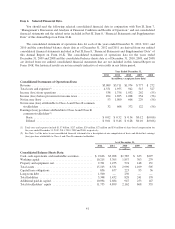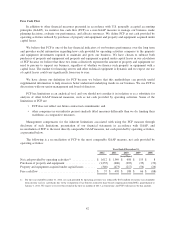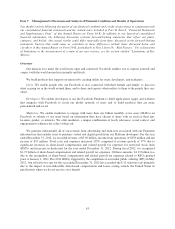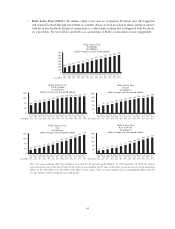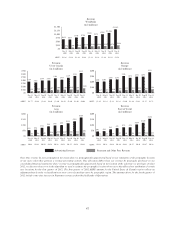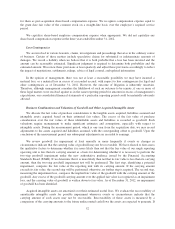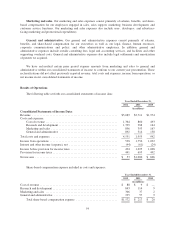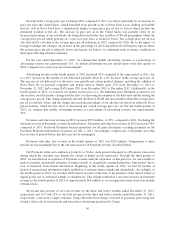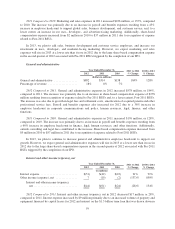Facebook 2012 Annual Report Download - page 55
Download and view the complete annual report
Please find page 55 of the 2012 Facebook annual report below. You can navigate through the pages in the report by either clicking on the pages listed below, or by using the keyword search tool below to find specific information within the annual report.We record a provision for income taxes for the anticipated tax consequences of the reported results of
operations using the asset and liability method. Under this method, we recognize deferred tax assets and
liabilities for the expected future tax consequences of temporary differences between the financial reporting and
tax bases of assets and liabilities, as well as for operating loss and tax credit carryforwards. Deferred tax assets
and liabilities are measured using the tax rates that are expected to apply to taxable income for the years in which
those tax assets and liabilities are expected to be realized or settled. We record a valuation allowance to reduce
our deferred tax assets to the net amount that we believe is more likely than not to be realized.
We recognize tax benefits from uncertain tax positions only if we believe that it is more likely than not that
the tax position will be sustained on examination by the taxing authorities based on the technical merits of the
position. Although we believe that we have adequately reserved for our uncertain tax positions, we can provide
no assurance that the final tax outcome of these matters will not be materially different. We make adjustments to
these reserves when facts and circumstances change, such as the closing of a tax audit or the refinement of an
estimate. To the extent that the final tax outcome of these matters is different than the amounts recorded, such
differences will affect the provision for income taxes in the period in which such determination is made and
could have a material impact on our financial condition and operating results. The provision for income taxes
includes the effects of any reserves that we believe are appropriate, as well as the related net interest and
penalties.
Share-based Compensation
Prior to January 1, 2011 we granted Pre-2011 RSUs to our employees and members of our board of
directors that vested upon the satisfaction of both a service-based condition, generally over four years, and a
liquidity condition. The liquidity condition was satisfied in connection with our IPO in May 2012. Because the
liquidity condition was not satisfied until our IPO, in prior periods we had not recorded any expense relating to
the granting of the Pre-2011 RSUs. In the second quarter of 2012, we recognized $986 million of stock-based
compensation expense associated with Pre-2011 RSUs that vested in connection with our IPO. For the Pre-2011
RSUs, we recognize share-based compensation expense using the accelerated attribution method, net of
estimated forfeitures, in which compensation cost for each vesting tranche in an award is recognized ratably from
the service inception date to the vesting date for that tranche.
RSUs granted on or after January 1, 2011 (Post-2011 RSUs) are not subject to a liquidity condition in order
to vest, and compensation expense related to these grants is based on the grant date fair value of the RSUs and is
recognized on a straight-line basis over the applicable service period. The majority of Post-2011 RSUs are earned
over a service period of four to five years. For Post-2011 RSUs, which are only subject to a service condition, we
recognize share-based compensation expense on a ratable basis over the requisite service period for the entire
award.
We account for share-based employee compensation plans under the fair value recognition and
measurement provisions in accordance with applicable accounting standards, which require all share-based
payments to employees, including grants of stock options and RSUs, to be measured based on the grant-date fair
value of the awards.
Share-based compensation expense is recorded net of estimated forfeitures in our consolidated statements of
income and as such is recorded for only those share-based awards that we expect to vest. We estimate the
forfeiture rate based on historical forfeitures of equity awards and adjust the rate to reflect changes in facts and
circumstances, if any. We will revise our estimated forfeiture rate if actual forfeitures differ from our initial
estimates.
We have historically issued unvested restricted shares to employee stockholders of certain acquired
companies. As these awards are generally subject to continued post-acquisition employment, we have accounted
51


